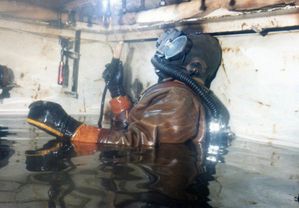 We were now in 1980 and the work on the Rupel tunnel was slowly approaching to his term.
We were now in 1980 and the work on the Rupel tunnel was slowly approaching to his term.
The last element had been placed with success in the river and we were now sealing the embankment side.
To realize this water tightness , we had previously built a 45 m long concrete beam on the bottom off the river and also made some hyperbaric welding under the element to fix a 45 m long bolted strip.
And now, one of the last operations consisted to install a “Gina*” gasket between this strip and the concrete beam.
Clearly this meant that to reach the workplace, we needed to go down some 24 m along the side of the element then pass under it and follow the concrete beam during a certain distance to be on the site.
Thus, this 25/06/80 I went down and follow the beam for about 20 m before I got to the place where a part of the gasket had already been fixed by the previous diver.
Once there, I informed the surface that I was in position and I started to work:
- First install a lugall to the beam
- then fix a clamp at the edge of the rubber seal,
- put some tension to the lugall in order to bring the seal over a series of bolts,
- and finally install a small plate over the gasket and fix it with some nuts to keep it in position.
Even in total darkness my work progressed well and I was not expecting to have any particular problem.
Unfortunately I was wrong. I was now diving for about 25’ when suddenly I fell completely without nitrox gas.
The gas failure wasn’t gradual, which would have meant that the quad at the surface was empty.
No, it was expiration of the gas from my lungs, then inspiration, and ..... Fuck, no gas anymore.
Of course bail out bottle was mandatory for this job and this time I was convinced that mine was full because I did control it before every dive since the incident that happened a few months before.
So I opened my bail out valve and .... Shit! Nothing.

What was the problem? No time to think at it.
Obviously, I was now an emergency situation and this even more because from here I couldn’t come up straight away.
So I immediately warned the surface to quickly pick up my umbilical and pull me back to the edge of the element.
Although I wanted to get out from underneath the element as fast as possible, I had to make sure that my hose was not going to be hooked by the bolds that were sticking out of the roof and therefore I preferred to feel the traction on my umbilical and simply follow it instead of moving quickly towards the edge and risking to leave behind me some slack that could be jammed somewhere.
Luckily, as usual in those days I was wearing my constant volume suit and hood, and thanks to that, I was sure that I could breathe the few liters of gas that were contained in it during at least 2 minutes before fainting.
The surface team reacted promptly and I could feel that they were doing their best to bring me back.
As soon as I reach the edge of the element, I immediately found the down line, so I told the surface to stop pulling at my umbilical for I was now coming up at the (nearly) requested ascent speed.
I knew that the ascent would expand the gas inside my suit and thus give me more to breathe, and so I reached the surface without further difficulty.
Of course, once out of the water, everybody wanted to know what had happened.
All the diving equipment was checked from the nitrox quad up to my regulator, and the trouble seemed to come from that last one.
I opened it and immediately saw what the problem was.
In those days I was using a MISTRAL, which was a one-stage double hose demand regulator. It was very pleasant and reliable to use except this day because now I could see that a small piece had come loose of his original position and had therefore failed to provide gas.
But in fact, the real cause off the failure came from the fact that during the previous days, I had done a lot of pneumatic drilling which had generated a lot of vibrations through my body, but also trough my equipment, and it were those vibrations that had slowly but surely turned loose that piece.
Conclusions: Always inspect your diving gear regularly and especially when it had been submitted to extreme working conditions.
* So named because its shape resembled to the breast of GINA LOLLOBRIGIDA which was a well-known actress in the 1960s.
Papy One



/idata%2F2368640%2FPlongee-nucleaire%2Fnucl.N.jpg)
/idata%2F2368640%2FPlongee-nucleaire%2Fnucl.M.jpg)
/idata%2F2368640%2FPlongee-nucleaire%2Fnucl.L.jpg)
/idata%2F2368640%2FPlongee-nucleaire%2Fnucl.K.jpg)
/idata%2F2368640%2FPlongee-nucleaire%2Fnucl.J.jpg)
/idata%2F2368640%2FPlongee-nucleaire%2Fnucl.I.jpg)
/idata%2F2368640%2FPlongee-nucleaire%2Fnucl.H.jpg)
/idata%2F2368640%2FPlongee-nucleaire%2Fnucl.G.jpg)
/idata%2F2368640%2FPlongee-nucleaire%2Fnucl.F.jpg)
/idata%2F2368640%2FPlongee-nucleaire%2Fnucl.E.jpg)
/idata%2F2368640%2FPlongee-nucleaire%2Fnucl.D.jpg)
/idata%2F2368640%2FPlongee-nucleaire%2Fnucl.C.jpg)
/idata%2F2368640%2FPlongee-nucleaire%2Fnucl.B.jpg)
/idata%2F2368640%2FPlongee-nucleaire%2Fnucl.A.jpg)
/idata%2F2368640%2FPlongee-nucleaire%2FPlongee-nucleaire-1952.JPG)



